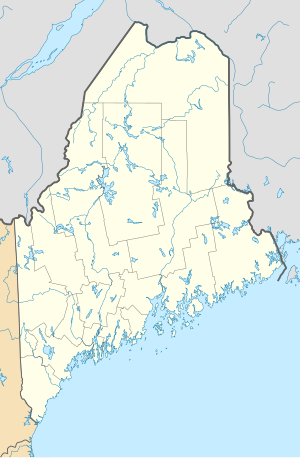Victory Chimes (schooner)
 |
|
| History | |
|---|---|
|
|
|
| Name: |
|
| Builder: | George K. Phillips Co., Bethel, Delaware; J.M.C. Moore, designer |
| Launched: | April 1900 |
| Homeport: | Rockland, Maine |
| Identification: | Official number 136784 |
| General characteristics | |
| Type: | Chesapeake Ram schooner |
| Tonnage: | 208 tons (gross), 178 tons (net) |
| Length: | 127.5 ft (38.9 m) |
| Beam: | 23.8 ft (7.3 m) |
| Draft: |
|
| Propulsion: | 210 hp (160 kW) Cummins diesel (2010) |
| Sail plan: | Three masted Gaff rigged schooner |
| Speed: | 7 knots (13 km/h; 8.1 mph) |
| Complement: | 9 crew members, 50 guests |
|
Victory Chimes
|
|
| Location | Rockland, Maine |
| Coordinates | 44°6′41″N 69°6′14″W / 44.11139°N 69.10389°WCoordinates: 44°6′41″N 69°6′14″W / 44.11139°N 69.10389°W |
| Built | 1900 |
| Architect | Moore, J.M.C. |
| Architectural style | Other |
| NRHP Reference # | 93000637 |
| Significant dates | |
| Added to NRHP | 24 June 1996 |
| Designated NHL | 25 September 1997 |
The three-masted schooner Victory Chimes, also known as Edwin and Maud or Domino Effect, is a US National Historic Landmark. She is the last surviving Chesapeake Ram schooner. The boat on the Maine State Quarter is meant to resemble the Victory Chimes.
Victory Chimes was built at Bethel, Delaware in 1900 by George K. Phillips Co. She was named Edwin and Maud after the children of her first Captain, Robert E. Riggen.
The traditional "ram" rig was a standing jib, flying jib, staysail (also called a forestaysail), foresail, mainsail and spanker (or mizzen), which Victory Chimes carries today. The heads of the fore, main and mizzen sails are supported by gaffs and the feet are laced to booms ... The standing rigging is steel wire. Standing rigging was minimal on rams, to enable deck cargo to be stowed on uncluttered decks.
She was designed to carry general cargo in the Chesapeake Bay. She was built with a centerboard, and a shallow draft for work in the Bay. Her centerboard, replaced in 1965, "draws 7 feet 6 inches with the centerboard up and 18 feet with the centerboard down."
Edwin and Maude served in the cargo trade until 1945 carrying "sawn lumber, grain, soft coal and fertilizer." She was converted to carry passengers in 1946.
She was renamed Victory Chimes after purchase by a syndicate in 1954, for charter in Maine. In 1984, the ship was purchased by a Minnesota banker, Jerry Jubie, "for about $1 million", who brought her to Duluth, Minnesota. She was used for educational cruises for high school students, sold at auction in 1987, and sold again by Norwest Bank in 1988 to Thomas Monaghan, the owner of Domino's Pizza. Monaghan renamed her Domino Effect. He used the vessel for employee incentive cruises, and invested a considerable amount of money in restoring her with traditional methods at Sample's Shipyard in Boothbay Harbor. The ship returned to Maine in 1989, where she was purchased by Captain Kip Files and Captain Paul DeGaeta in 1990 for the passenger trade. They changed her name back to Victory Chimes. In 1997, it was reported that the vessel was operating as a traditional sailing ship, without an engine on board.
...
Wikipedia

